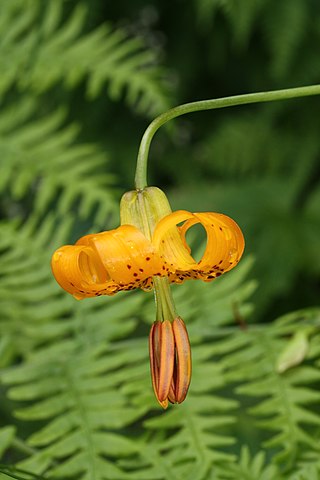
Lilium columbianum is a lily native to western North America. It is also known as the Columbia lily, Columbia tiger lily, or simply tiger lily.
Galium bolanderi is a species of flowering plant in the coffee family known by the common name Bolander's bedstraw. It is native to the mountains of California and southern Oregon. It is a resident of mountain forests and chaparral slopes.

Helianthus bolanderi is a species of sunflower known by the common names Bolander's sunflower and serpentine sunflower. It is native to California and Oregon, where it grows mainly in mountainous areas, often in serpentine soils. It has been found from southwestern Oregon as well as in northern and central California as far south as Santa Cruz County, with reports of a few isolated populations in southern California.
Allium bolanderi is a species of wild onion known by the common name Bolander's onion. It is native to northern California and southwestern Oregon, where it grows in the rocky soils of the Klamath Mountains and surrounding regions.

Astragalus bolanderi is a species of milkvetch known by the common name Bolander's milkvetch. It is native to western Nevada and parts of the Sierra Nevada in California. It grows in dry, rocky habitat on mountain and plateau.
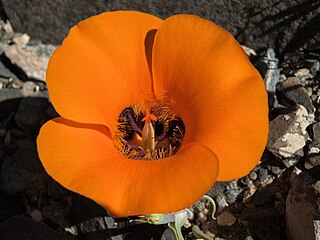
Calochortus kennedyi is a North American species of flowering plant in the lily family known by the common name desert mariposa lily.

Calochortus panamintensis is a rare North American species of flowering plants in the lily family known by the common name Panamint mariposa lily. It is native to Inyo and Kern Counties in California, plus adjacent Nye County, Nevada. It is named after the Panamint Range near Death Valley.
Eleocharis bolanderi, commonly known as Bolander's spikerush, is a species of spikesedge. It is native to the western United States from Colorado west to Oregon and California. It grows in wet spots in several types of habitat, including mountain meadows and springs. It is a rhizomatous perennial herb producing erect, hairless stems 10 to 30 centimeters tall. The narrow, wispy leaves often have purple or reddish speckles and purplish tinting around the bases. The inflorescence is an oval-shaped spikelet at the tip of the stem under a centimeter long and made up of several dark brown, sometimes purple-tinged flowers.
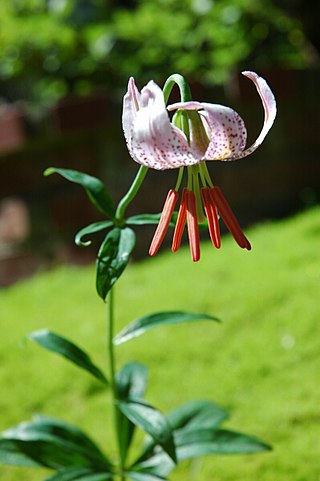
Lilium kelloggii is a species of lily known by the common name Kellogg's lily. It is endemic to the Klamath Mountains of northwestern California and southwestern Oregon, where it grows in forests, including those dominated by redwoods.

Lilium maritimum is a species of lily known by the common name coast lily. It is endemic to California, where it is known only from the coastline north of San Francisco. It formerly occurred south of San Francisco, but these occurrences have all been extirpated. The species is now restricted to the North Coast from Marin County to Del Norte County, and is most common in Mendocino County. It grows in the California coastal prairie habitat, coniferous forests, and bogs amongst Drosera species.

Lilium occidentale is a rare North American species of lily known by the common name western lily. Its species name 'Occidentale' means 'westernmost' and refers to its location along the West Coast. It is native to northwestern California and southwestern Oregon. It grows in coastal prairie habitat, swamps and stagnant bogs with Drosera species, bluffs and sandy cliffs, and seaside spruce forests. This rare wildflower is limited in distribution and directly endangered by a number of environmental factors. It is a federally listed endangered species and it is listed as endangered by the states of California and Oregon.
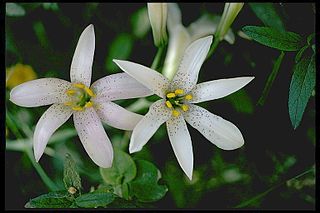
Lilium rubescens is an uncommon species of lily known by the common names redwood lily and chaparral lily. It is native to northwestern California and southwestern Oregon, where it is known from the Coast Ranges from Lane County to Santa Cruz Counties.
Kyhosia is a monotypic genus of flowering plants in the family Asteraceae containing the single species Kyhosia bolanderi, which is known by the common names Bolander's madia and kyhosia.
Diplacus bolanderi is a species of monkeyflower known by the common name Bolander's monkeyflower.

Perideridia bolanderi is a species of flowering plant in the family Apiaceae known by the common name Bolander's yampah. It is native to the western United States, where it grows in many types of habitat. It is a perennial herb which may approach one meter in maximum height, its slender, erect stem growing from tubers measuring up to 7 centimeters long. Leaves near the base of the plant have blades up to 20 centimeters long which are divided into many subdivided lobes of various sizes and shapes; the terminal segments are usually lined with teeth. Leaves higher on the plant are smaller and less divided. The inflorescence is a compound umbel of many spherical clusters of small white flowers. These yield ribbed, oblong-shaped fruits about half a centimeter long. The Atsugewi and Miwok of California used the tuberous roots of this plant for food.
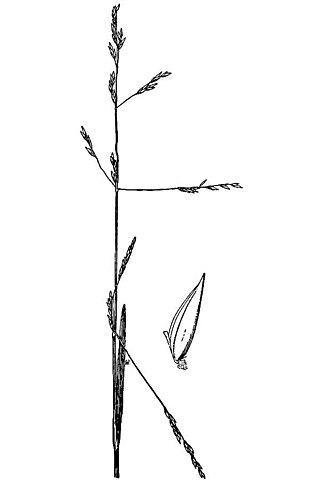
Poa bolanderi is a species of grass known by the common name Bolander's bluegrass. It is native to western North America from British Columbia to Utah to California, where it is a resident of mountain habitat, particularly pine and fir forests. It is an annual grass growing in clumps up to 60 centimeters tall. The inflorescence occupies the top 10 to 15 centimeters of the stem. It is narrow in flower, with branches appressed, growing parallel to the stem. As the fruit develops the branches spread out, becoming perpendicular to the stem, nodding, or drooping. The branches have few, sparse spikelets.

Ranunculus eschscholtzii is a species of buttercup flower known by the common name Eschscholtz's buttercup.

Packera bolanderi is a species of flowering plant in the aster family known by the common names Bolander's ragwort and seacoast ragwort. It is native to the west coast of the United States from Washington to northern California, where it grows in wet coastal forests and woodlands. There are two varieties of the species which differ slightly in morphology and habitat occupied; these varieties have been considered separate species by some authors. The var. bolanderi has thicker leaves, occurs farther south, and occupies more open types of habitat, than does var. harfordii. This plant in general is a perennial herb producing one to three stems up to half a meter tall. The basal leaves have blades up to 12 centimeters long which are divided into several lobes and borne on long, thin petioles. Leaves growing farther up the stem are smaller and have more lobes on their blades. The inflorescence contains several flower heads, each lined with dark green phyllaries. The head contains many golden yellow disc florets and generally either 8 or 13 yellow ray florets each over a centimeter long. The fruit is an achene tipped with a pappus of bristles.
Trifolium bolanderi is a species of clover known by the common names Bolander's clover and parasol clover.
Agnorhiza bolanderi is a species of flowering plant known by the common name Bolander's mule's ears. It is endemic to California, where it is known only from a narrow section of the Sierra Nevada foothills about 275 kilometers long from Shasta County to Mariposa County. It grows in chaparral and grassland habitat, usually on serpentine soils.













